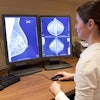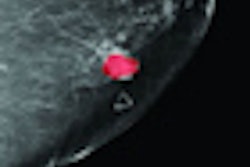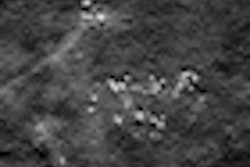Screening mammography doesn't perform well in finding bilateral breast cancers, with a sensitivity rate of only 19%, according to a new study published online in Radiology. The findings suggest that radiologists may need to look harder for contralateral cancers, or even use another modality such as breast MRI, Dutch researchers said.
Lead author Dr. Wikke Setz-Pels, of Catharina Hospital in Eindhoven, the Netherlands, and colleagues wanted to investigate the prevalence of bilateral breast cancer at screening. Several previous studies have shown that women with cancer in both breasts have worse outcomes than those with cancer in a single breast. Therefore, detecting cancer in the opposite breast at screening is key (Radiology, April 7, 2011).
The researchers used data collected from 302,196 analog screening mammograms obtained in 80,466 women over a 10-year time period (1998 to 2008). Women who participated in the study were between the ages of 50 and 75; the exams were acquired at one fixed breast imaging center and one mobile mammography unit in the southern Netherlands. Each woman had mediolateral oblique and craniocaudal views of each breast taken at the initial exam. Eleven radiologists participated in the screening program during the study period.
During a follow-up period of about two years, the team collected mammography findings, clinical data, additional breast imaging reports, biopsy results, and breast surgery results from all women with a positive screening result. Most interval cancers were identified by linking the screening records to the regional cancer registry.
At the two-year follow-up mark, 1,555 women had been diagnosed with breast cancer, for a detection rate of 5.1 per 1,000 women screened, and a true-positive referral rate of 40.9%. Also at the two-year follow-up mark, 585 women had been diagnosed with interval breast cancer, Setz-Pels and colleagues wrote.
A total of 52 women were found to have bilateral breast cancer. Of the 1,555 women diagnosed with screening-detected cancers, 41 had bilateral breast cancer, while of the 585 women with interval cancers, 11 had bilateral cancer, the authors wrote. Ten of the 52 women with bilateral cancer (including those with bilateral interval cancer) were referred for further evaluation of a suspicious finding in the opposite breast at screening mammography, for a sensitivity rate of 19%, the team found.
Thirty-one of these 52 women were referred to follow-up for a suspicious finding in one breast; the tumor in the other breast was found within three months after referral in 16 women and in more than three months after referral in 15 women.
Of the total 52 bilateral cancers, 68.3% were invasive ductal cancers, 24% were invasive lobular cancers, and 7.7% were ductal carcinoma in situ.
Why the missed cancers? Radiologists may be seeing what they want to see, according to Setz-Pels and colleagues.
"Review showed that most of the contralateral breast cancers in women who had been referred for a unilateral lesion only (and in whom the contralateral tumor was detected within three months) had been missed at screening," they wrote. "An important cause for missing contralateral cancers may be the happy eye syndrome, or satisfaction of search. The observation of a suspicious lesion may mislead a screening radiologist into not looking carefully for other, contralateral lesions."
The authors conceded that one of the study's limitations was that the mammograms were taken on analog units -- and that the study could not, therefore, predict the effect of digital screening on the detection of bilateral cancers. (In the Netherlands, the nationwide screening program has recently completed conversion from analog to digital breast imaging, they wrote.)
Breast MRI to the rescue?
In women with newly diagnosed breast cancer, contrast-enhanced MRI has been shown to be highly sensitive in finding opposite-breast cancers that occur at the same time as the presenting lesion, as well as high-risk lesions, according to Setz-Pels and colleagues.
"Compared with conventional mammography, contrast-enhanced MR imaging has a higher sensitivity for detecting invasive lobular cancers and may be used for a more accurate determination of tumor size, tumor multifocality, and pectoral muscle invasion by tumor growth," they wrote.




















